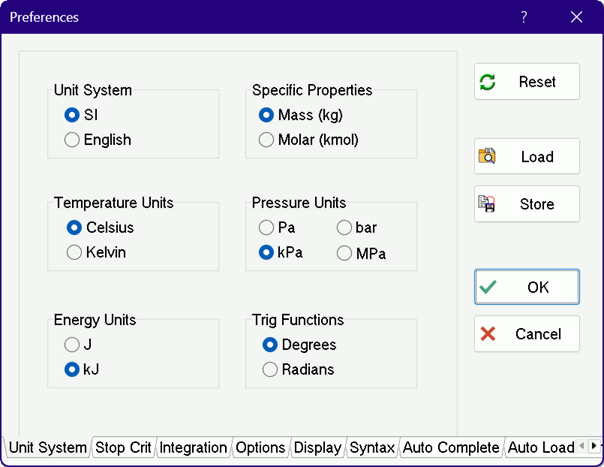
Unit System

The Units System command in the Options menu provides access to the Unit System dialog. The Unit System dialog, located on the first tab of the Preferences dialog, allows the units that will be used in the built-in mathematical and thermophysical property functions to be specified for the main program. Note that Functions, Procedures, Subprograms and Modules use the unit settings made in the main program unless there a $UnitSystem directive is used to indicate otherwise.
The unit system information will be changed just for the duration of the problem session if the OK button is pressed. Note that the selected units are saved with other problem information when the Save or Save As command in the File menu is issued. This information is then restored with the problem using the Open command.
The Store button will save the unit system information along with information on other tabs in the Preferences dialog in an EES Preferences (*.prf) file in the working directory. Unit system specifications are saved with other file information when an .EES file is saved so that the Store button is needed only to store default values in a .prf file. An existing .prf file from any directory can also be loaded with the Load button or with a $INCLUDE directive.
Specific Properties controls the units for specific enthalpy, internal energy, entropy, and volume. When Mass Basis is selected, these property values will be determined on a per unit mass (kg or lbm) basis. When Mole Basis is selected, the specific property values will be determined on a per unit mole (kmol or lbmol) basis.
The Energy Units group only appears when the Unit System is selected to be SI. If J is selected, specific internal energy and enthalpy will be in units of J/kg or J/kmol, depending on the Specific Properties selection. Specific entropy will be in J/kg-K or J/kmol-K. A convenient choice of units is pressure in Pa and Energy in J since this combination avoids the need to provide a conversion factor of 1000 into equations. However, with the Convert function and Unit Checking capabilities built into EES, the unit system choices are not really important in this respect.
The unit system information is only needed for built-in function calls. EES does not provide automatic unit conversion for the values of variables although it can provide automatic unit checking of your equations. The built-in property functions expect all inputs and outputs to have the units specified in the Unit System dialog.
Note that the unit system can also be set with the $UnitSystem directive and the current unit settings can be determined within an EES program using the UNITSYSTEM function.
When the Unit System is changed from SI to English or from English to SI, EES will load the default English or SI units list (SI_DefaultUnits.unt or ENG_DefaultUnits.unt), provided that no unsaved changes have been made to the current units list. The files are stored in the working directory.
The unit system choices are shown in the status bar at the bottom of the Equations window. Clicking in the units cell on the status bar will bring up the Unit System dialog.
See also: Preferences